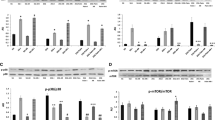Abstract
To investigate if increased activation of matrix metalloproteinases (MMPs) may contribute to the large cardiovascular risk associated with obesity-related insulin resistance, we examined the effects of physiologically elevated levels of insulin and free fatty acid (FFA) on three MMPs and their physiologic inhibitors (tissue inhibitors of MMP [TIMPs]) in aortic tissue of male rats during euglycemic-hyperinsulinemic clamping. Hyperinsulinemia increased the active forms of MMP-2 (∼ sixfold), MMP-9 (∼ 13-fold), and membrane type 1-MMP (MT1-MMP; ∼ eightfold) (all Western blots), and the gelatinolytic activity (zymography) of MMP-2 (twofold); it did not affect TIMP-1 and TIMP-2. FFA augmented the insulin-mediated increases in MMP-2 (from ∼ six-to ∼ 11-fold), MMP-9 (from ∼ 13-to ∼ 23-fold), MT1-MMP (from ∼ eight-to ∼ 20-fold), and MMP-2 gelatinolytic activity (from two-to threefold). FFA also increased JNK and p38 mitogen-activated protein kinase activities. The insulin-and FFA-induced hyperactivity of three proatherogenic MMPs in vascular tissues may promote degradation of extracellular matrix over time, leading to thinning of atherosclerotic capsules and acute vascular problems.
Similar content being viewed by others
References and Recommended Reading
Reaven GM: The role of insulin resistance in human disease. Diabetes 1988, 37:1595–1607.
Hennekens CH: Increasing burden of cardiovascular disease: current knowledge and future directions for research on risk factors. Circulation 1998, 97:1095–1102.
Newby AC: Dual role of matrix metalloproteinases (matrixins) in intimal thickening of atherosclerotic plaque rupture. Physiol Rev 2005, 85:1–31.
Bendeck MP, Zempo N, Clowes AW, et al.: Smooth muscle cell migration and matrix metalloproteinase expression after arterial injury in the rat. Circ Res 1994, 75:539–545.
Galis ZS, Sukhova GK, Lark MW, Libby P: Increased expression of matrix metalloproteinases and matrix degrading activity in vulnerable regions of human atherosclerotic plaques. J Clin Invest 1994, 94:2493–2503.
Pasterkamp G, Schoneveld AH, Hijnen DJ, et al.: Atherosclerotic arterial remodeling and the localization of macrophages and matrix metalloproteinases 1, 2 and 9 in the human coronary artery. Atherosclerosis 2000, 150:245–253.
Goodall S, Porter KE, Bell PR, Thompson MM: Enhanced invasive properties exhibited by smooth muscle cells are associated with elevated production of MMP-2 in patients with aortic aneurysms. Eur J Vasc Endovasc Surg 2002, 24:72–80.
Longo GM, Xiong W, Greiner TC, et al.: Matrix metalloproteinases 2 and 9 work in concert to produce aortic aneurysms. J Clin Invest 2002, 110:625–632.
Blankenberg S, Rupprecht HJ, Poirier O, et al.: Plasma concentrations and genetic variation of matrix metalloproteinase 9 and prognosis of patients with cardiovascular disease. Circulation 2003, 107:1579–1585.
Tataranni PA, Ortega E: A burning question: does an adipokine-induced activation of the immune system mediate the effect of overnutrition on type 2 diabetes? Diabetes 2005, 54:917–927.
Visse R, Nagase H: Matrix metalloproteinases and tissue inhibitors of metalloproteinases. Structure, function and biochemistry. Circ Res 2003, 92:827–839.
Reaven GM, Hollenbeck C, Jenk CY, et al.: Measurement of plasma glucose, free fatty acid, lactate and insulin for 24 h in patients with NIDDM. Diabetes 1998, 37:1020–1024.
Boden G, She P, Mozzoli M, et al.: Free fatty acids produce insulin resistance and activate the proinflammatory nuclear factor-kappaB pathway in rat liver. Diabetes 2005, 54:3458–3465.
Boden G: Role of fatty acids in the pathogenesis of insulin resistance and NIDDM. Diabetes 1997, 46:3–10.
Saltiel RA, Kahn CR: Insulin signaling and the regulation of glucose and lipid metabolism. Nature 2001, 414:799–806.
Seger R, Krebs EG: The MAPK signaling cascade. FASEB J 1995, 9:726–735.
Jiang ZY, Lin YW, Clemont A, et al.: Characterization of selective resistance to insulin signaling in the vasculature of obese Zucker (fa/fa) rats. J Clin Invest 1999, 104:447–457.
Cusi K, Maezono K, Osman A, et al.: Insulin resistance differentially affects the PI 3-kinase-and MAP kinase-mediated signaling in human muscle. J Clin Invest 2000, 105:11–20.
Hirosumi J, Tuncman G, Chang L, et al.: A central role for JNK in obesity and insulin resistance. Nature 2002, 420:333–336.
Miller BS, Shankavaram UT, Horney MJ, et al.: Activation of cJun NH2-terminal kinase/stress-activated protein kinase by insulin. Biochem 1996, 35:8769–8775.
Malhi H, Bronk SF, Werneburg NW, Gores GJ: Free fatty acids induce JNK-dependent hepatocyte lipoapoptosis. J Biol Chem 2006, 281:12093–12101.
Gao Z, Zhang X, Zuberi A, et al.: Inhibition of insulin sensitivity by free fatty acids requires activation of multiple serine kinases in 3T3-L1 adipocytes. Mol Endocrinol 2004, 18:2024–2034.
Ozcan U, Cao Q, Yilmaz E, et al.: Endoplasmic reticulum stress links obesity, insulin action, and type 2 diabetes. Science 2004, 306:457–461.
Cuenda A, Cohen P, Buee-Scherrer V, Goedert M: Activation of stress-activated kinase-3 (SAPK3) by cytokines and cellular stresses is mediated via SAPKK3 (MKK6): comparison of the specificities of SAPK3 and SAPK2 (RK/p38). EMBO J 1997, 16:295–305.
Collins QF, Xiong Y, Lupo EG, et al.: p38 Mitogen-activated protein kinase mediates free fatty acid-induced gluconeogenesis in hepatocytes. J Biol Chem 2006, 281:24336–24344.
Raingeaud J, Gupta S, Rogers JS, et al.: Pro-inflammatory cytokines and environmental stress cause p38 mitogen-activated protein kinase activation by dual phosphorylation on tyrosine and threonine. J Biol Chem 1995, 270:7420–7426.
Miller TA, LeBrasseur NK, Cote GM, et al.: Oleate prevents palmitate-induced cytotoxic stress in cardiac myocytes. Biochem Biophys Res Commun 2005, 336:309–315.
Dersch K, Ichijo J, Bhakdi S, Husmann M: Fatty acids liberated from low-density lipoprotein trigger endothelial apoptosis via mitogen-activated protein kinases. Cell Death Differ 2005, 12:1107–1114.
Zarubin T, Han J: Activation and signaling of the p38 MAP kinase pathway. Cell Res 2005, 15:11–18.
Boden G, Song W, Pashko L, Kresge K: In vivo effects of insulin and free fatty acids on matrix metalloproteinases in rat aorta. Diabetes 2008, 57:476–483.
Author information
Authors and Affiliations
Corresponding author
Rights and permissions
About this article
Cite this article
Boden, G., Song, W.W. Effects of insulin and free fatty acids on matrix metalloproteinases. Curr Diab Rep 8, 239–242 (2008). https://doi.org/10.1007/s11892-008-0041-y
Published:
Issue Date:
DOI: https://doi.org/10.1007/s11892-008-0041-y




